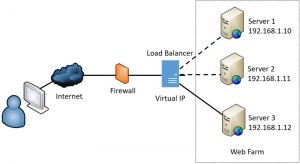Load Balancing
CompTIA Security+|MTA Security – Load Balancing
CompTIA Security+ Section 2.0
Load Balancer
Definition: “Load balancing is defined as the methodical and efficient distribution of network or application traffic across multiple servers in a server farm.”
A load balancer works in-between client devices and back end servers, and it receives then distributes incoming requests to any available server capable of fulfilling them. It can be either physical hardware, a virtualized instance running on specialized hardware or a software process.
Scheduling:
Affinity – “an affinity means that the load balancer will always use the same server for a particular user or a particular application instance.”
Round-Robin – “One type of scheduling is called round-robin scheduling where each server is selected in turn. And if round-robin scheduling is set for 1 to 1, then the first bit of traffic will go to Server A. The second bit of traffic through the load balance will be scheduled to Server B. The third type of traffic through the load balancer will be scheduled to Server C. And because this load balancer is scheduling in a round-robin method, the last bit will go to Server D.”
Active – Passive: “Some load balancers can be configured for active/passive load balancing. That means that some servers will be currently active and able to take requests, and other servers are on standby.”
Active – Active: “That means that all of these servers are active. And requests coming through the load balancer could use any of these active servers at any time.” If any server fails, then “the load balancer will identify the failure and begin using one of the standby servers in its place.”

Why is it necessary?
“An ADC with load balancing capabilities helps IT departments ensure scalability and availability of services. Its advanced traffic management functionality can help a business steer requests more efficiently to the correct resources for each end user. An ADC offers many other functions (for example, encryption, authentication and web application firewalling) that can provide a single point of control for securing, managing and monitoring the many applications and services across environments and ensuring the best end-user experience.”
Sources: Professor Messer, Citrix, Get Certified Get Ahead
Are you looking to break into the exciting field of Cybersecurity? Join our 5-day CompTIA Security+ Bootcamp and build your cybersecurity knowledge and skills.
OR
Become a certified ethical hacker! Our 5-day CEH Bootcamp is unlike other strictly theoretical training, you will be immersed in interactive sessions with hands-on labs after each topic. You can explore your newly gained knowledge right away in your classroom by pentesting, hacking and securing your own systems. Learn more






